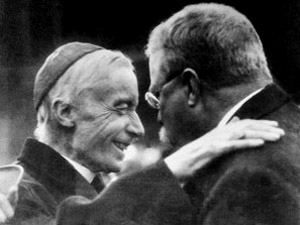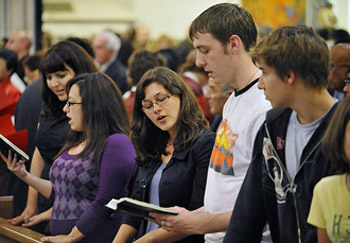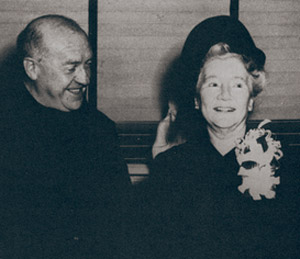Traditionalist Issues
 |
 |
 |
 |
 |
 |
 |
Dialogue Mass - VIII
Pius XI Endorses the Liturgical Revolution
In the years preceding 1928 when the Apostolic Constitution Divini Cultus by Pius XI was issued, the main thrust for congregational singing came from the following sources:
If we scratch the surface of Divini Cultus, we can see a quiet revolution taking place to “open up” the liturgy to popular involvement. It also shows a growing contempt for the norms imposed by Pius X on women choir members, particularly from the American (Americanist) Bishops led by Card. James Gibbons, (5) who had refused in 1904 to implement Pius X’s ban. (6) (See article here)
A feminist putsch
The really revolutionary element of Divini Cultus, however, is that female singers of the liturgical texts were promoted by Pope Pius XI himself. As we have seen with his blessing of Justine Ward’s work, he had already approved girl choristers, even though they had been banned by his predecessor.
 Whereas Pius X ordered that liturgical chant should be taught to seminarians and clerics and restricted to their use, Pius XI extended this instruction to the whole Catholic population, starting in the schools. He told heads of religious communities of women as well as men to “devote particular attention to the achievement of this purpose in the various educational institutions committed to their care.” (7)
Whereas Pius X ordered that liturgical chant should be taught to seminarians and clerics and restricted to their use, Pius XI extended this instruction to the whole Catholic population, starting in the schools. He told heads of religious communities of women as well as men to “devote particular attention to the achievement of this purpose in the various educational institutions committed to their care.” (7)
This not only means that females were also allowed to perform a liturgical function, but that choirs should be formed for their instruction in the Chant. It was a concession to the recalcitrant American Bishops. Predictably, it led to a divisive situation with Bishops everywhere taking the part of Pius XI against Pius X and leading the faithful to do likewise.
Silent participation is stigmatized and becomes taboo
Everyone in the ambit of the Novus Ordo has by now accepted as something unassailably correct that silent participation in the liturgy is to be utterly eschewed. But that idea did not originate with Pope Pius X.
It all started with Beauduin’s launching of the Liturgical Movement and was officially enshrined for the first time in a papal document by Pius XI who indicated in Divini Cultus his desire for vocal participation by all:
 “It will no longer happen that the people either make no answer at all to the public prayers – whether in the language of the Liturgy or in the vernacular – or at best utter the responses in a low and subdued manner.” (8)
“It will no longer happen that the people either make no answer at all to the public prayers – whether in the language of the Liturgy or in the vernacular – or at best utter the responses in a low and subdued manner.” (8)
A disturbing feature of this remark is its emphasis on both externalism and intolerance. No one can claim with any certainty that it is only when the faithful sing that the Sacred Music promotes their participation. Nor can it be established that participation will be enhanced by raising the decibel level in the pews. Pope Pius X, for his part, had never made such claims.
‘Detached and silent spectators’
The origin of such claims can be traced to Beauduin’s ill-conceived theories for “active participation.” These were followed by Pius XI and called in evidence to refuse countenance to Catholics wishing to pray silently during Mass – whom he termed “detached and silent spectators.” The Pope’s choice of words was perhaps more revealing than he intended: They echo the very words used by Beauduin to launch his liturgical revolution. (9)
These words display a disregard for the crucial distinction between detachment and silence. Both are conflated in Divini Cultus and given equally negative publicity, an opprobrium that also attaches to Catholics who choose not to make their voices heard during Mass. Henceforth they will be fed to the liturgical lions to be harried, mocked, rebuked, cajoled, placed under suspicion, publicly denounced and sent on a guilt trip to make them sing/shout up during Mass.
Pius XII followed, not Pius X, but Pius XI on the same revolutionary pathway, as we will see in the next article.
Continued

- The American Bishops who had been campaigning for it for decades before the official start of the Liturgical Movement by Dom Lambert Beauduin; (1)
- Virgil Michel’s Orate Fratres, founded in 1927 to further Beauduin’s aims for “active participation” in the liturgy;
- Bishops and Benedictine Abbots in France, Germany and Belgium who were already allowing various forms of “active participation” in the liturgy;
- Musical congresses, societies and publications wishing to increase their professional profile;
- Particularly the work of Justine Ward, a wealthy benefactress to the Church, who had organized the 1920 International Congress on Gregorian Chant at St Patrick’s Cathedral in New York.

Dom Joseph Gajard of Solemnes promoted Justine Ward and her method of singing
If we scratch the surface of Divini Cultus, we can see a quiet revolution taking place to “open up” the liturgy to popular involvement. It also shows a growing contempt for the norms imposed by Pius X on women choir members, particularly from the American (Americanist) Bishops led by Card. James Gibbons, (5) who had refused in 1904 to implement Pius X’s ban. (6) (See article here)
A feminist putsch
The really revolutionary element of Divini Cultus, however, is that female singers of the liturgical texts were promoted by Pope Pius XI himself. As we have seen with his blessing of Justine Ward’s work, he had already approved girl choristers, even though they had been banned by his predecessor.

Americanist Card. Gibbons was a friend of Roosevelt and an opposer of St. Pius X
This not only means that females were also allowed to perform a liturgical function, but that choirs should be formed for their instruction in the Chant. It was a concession to the recalcitrant American Bishops. Predictably, it led to a divisive situation with Bishops everywhere taking the part of Pius XI against Pius X and leading the faithful to do likewise.
Silent participation is stigmatized and becomes taboo
Everyone in the ambit of the Novus Ordo has by now accepted as something unassailably correct that silent participation in the liturgy is to be utterly eschewed. But that idea did not originate with Pope Pius X.
It all started with Beauduin’s launching of the Liturgical Movement and was officially enshrined for the first time in a papal document by Pius XI who indicated in Divini Cultus his desire for vocal participation by all:

"Catholics must participate actively in divine worship"
A disturbing feature of this remark is its emphasis on both externalism and intolerance. No one can claim with any certainty that it is only when the faithful sing that the Sacred Music promotes their participation. Nor can it be established that participation will be enhanced by raising the decibel level in the pews. Pope Pius X, for his part, had never made such claims.
‘Detached and silent spectators’
The origin of such claims can be traced to Beauduin’s ill-conceived theories for “active participation.” These were followed by Pius XI and called in evidence to refuse countenance to Catholics wishing to pray silently during Mass – whom he termed “detached and silent spectators.” The Pope’s choice of words was perhaps more revealing than he intended: They echo the very words used by Beauduin to launch his liturgical revolution. (9)
These words display a disregard for the crucial distinction between detachment and silence. Both are conflated in Divini Cultus and given equally negative publicity, an opprobrium that also attaches to Catholics who choose not to make their voices heard during Mass. Henceforth they will be fed to the liturgical lions to be harried, mocked, rebuked, cajoled, placed under suspicion, publicly denounced and sent on a guilt trip to make them sing/shout up during Mass.
Pius XII followed, not Pius X, but Pius XI on the same revolutionary pathway, as we will see in the next article.
Continued
- At the Third Plenary Council of Baltimore (1884), they demanded that “the major part at least of the faithful will learn to chant with clergy and choir in the Vesper service and suchlike.” (Acta et Decreti Concilii Plenarii Baltimorensis, Baltimore, John Murphy and Co., 1886, no. 119).
- Pierre Combe, Justine Ward and Solesmes, The Catholic University of America Press, 1992, p. 5.
- Ibid., p. 95.
- Ibid., p. 396.
- Archbishop (later Cardinal) James Gibbons who presided over the Third Plenary Council of Baltimore, was an enthusiastic promoter of congregational singing and wrote extensively on its alleged benefits in The Ambassador of Christ, Baltimore, J. Murphy and Co., 1896, pp. 354-5.
- New York Times, 12 May 1904.
- Pius XI, Divini Cultus of December 20, 2918.
- Ibid.
- L. Beauduin, Questions Liturgiques et Paroissiales, Abbey of Mont César, Louvain, 1922, pp. 50 and 52.

Posted June 16, 2014
______________________
______________________
 Volume I |
 Volume II |
 Volume III |
 Volume IV |
 Volume V |
 Volume VI |
 Volume VII |
 Volume VIII |
 Volume IX |
 Volume X |
 Volume XI |
 Special Edition |


